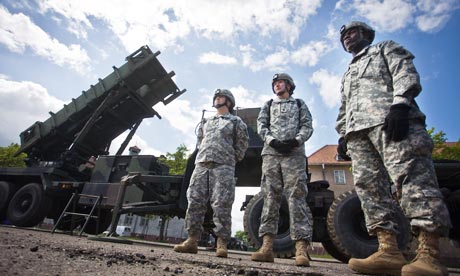

WikiLeaks cables: Poland wants missile shield to protect against Russia
Publicat de Mr. Miaghy la 01:08

The Obama administration has told Poland that a new proposed US andNato missile shield system aimed at destroying potential rocket attacks from Iran or Syria could be adapted to thwart "missiles coming from elsewhere".
Both Warsaw and Moscow are certain to view the remarks as evidence that the shield could be used to deter Russia, despite regular public statements to the contrary.
In meetings in Warsaw a year ago, senior US officials also unveiled a menu of possible US military deployments in Poland in response to years of Polish pressure to get "US boots on the ground."
The confidential US diplomatic traffic dealing with the missile shield, military links, and Poland's constant angst about its insecurity and vulnerability to Russia, reveals acute differences between Washington and Warsaw over the deployment of US Patriot air defences in Poland which started earlier this year.
Under the Bush administration, Poland agreed to host 10 missile interceptors for a proposed anti-ballistic missile defence system, a project that triggered a crisis in US-Russian relations. Barack Obama abandoned the scheme in September last year, under his policy of "resetting" relations with Russia.
The Pentagon and Nato are developing a more modest and mobile phased missile shield, inviting the Russians to take part. At a Nato summit in Lisbon last month, the allied leaders agreed for the first time to press ahead with the project and President Dmitry Medvedev of Russia was cautiously positive on the prospects for Moscow's co-operation.
In November last year, Alexander Vershbow, the assistant defence secretary for international security, offered the Poles a role in the new project by hosting a land-based "standard missile-3" system, as seen in the leaked US embassy cables.
The Poles, who have repeatedly told the Americans that they feel unthreatened by Iran but are regularly alarmed about Russia, asked "a series of hypothetical questions on the adaptive nature of the system vis-a-vis the changing threat".
"With regard to how Nato might defend itself from missiles coming from elsewhere than Iran or Syria, BG John Hesterman of the joint staff said that sea-borne platforms could provide surge capability against threats from an unforeseen direction, land-based sites could be upgraded with more interceptors if the scale of the threat were increased, and radars could be reoriented," the US embassy in Warsaw reports following the meetings.
A series of cables going back over the past two years highlights the Polish eagerness to try to draw the US military, Nato assets, and possibly military bases into Poland, and a clear US ambivalence and wariness, sparking furious rows and mutual exasperation.
"How long will it take you to realise that nothing will change with Iran and Russia?" a Polish presidential aide asks a trio of visiting US senators in May last year.
"The Polish prime minister's chief of staff, the president's deputy national security advisor, and the speaker of the Polish parliament expressed unanimous support for a large US military footprint in Poland … Most important for Poland is US involvement in Polish security, through physical presence of American forces in Poland, Nato facilities in Poland, fulfilling the commitment to provide Patriot missiles," the embassy reports. Six months later, Vershbow offered an alternative to the promised Patriots "which the US believed may be more useful to Poland".
"The three options presented were: 1) a quarterly rotation of F-16s, and the establishment of a small permanent support detachment, which would focus on enhancing Polish fighter capabilities, increasing sortie readiness and meeting Nato commitments; 2) quarterly C-130 rotations from Ramstein [airbase in Germany], also with a small permanent support detachment in Poland with the goal of increasing Polish readiness and ability to support own and Nato operations; 3) the relocation of a US naval special warfare unit from Stuttgart to Gdansk or Gdynia [on the Baltic coast]."
The Poles were enthusiastic, seeking to maximise the US offers. In February this year, the defence minister, Bogdan Klich, told the US ambassador, Lee Feinstein, in Warsaw that Poland was interested in all the options, particularly the F-16 fighter aircraft. Under government cost-cutting, Poland was closing down 20% of military facilities "but would be saving three complexes for US forces," Klich said.
Radek Sikorski, the Polish foreign minister, also told Ellen Tauscher, the US under-secretary of state for arms control, that Warsaw was interested in the F-16s.
0 Comments:
Postare mai nouă Postare mai veche Pagina de pornire
Abonați-vă la:
Postare comentarii (Atom)

















